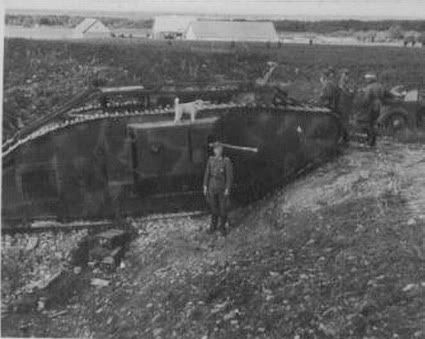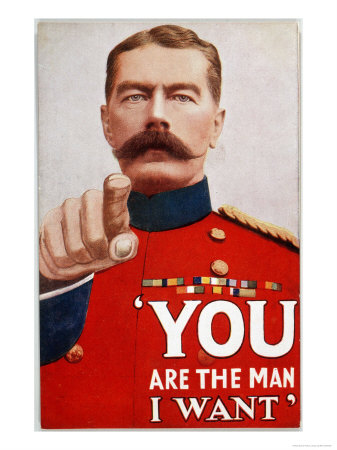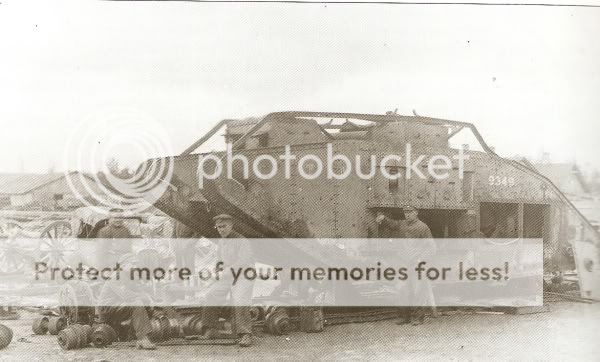Those of you who know me, know that I love weird vehicles, especially captured or really out of place oddities. Well 8 months ago I found out about a battle with four tanks, and have been trying to track the details down. I'm certain there's a story there. But after 8 months I can't find anything from English sources. So its over to you, can you find out anything about this Battle past what I detail below?
During the post World War One period, much of Eastern Europe became a mass of conflicting ideals and political groups and fighting. In most cases each country had its war of independence during the time. However the wider period is sometimes, inaccurately, called the Russian Civil War. Where White and Red Russians fought each other. The Whites and the nationalists were often supported by the west. Equally the differing groups were armed and equipped by the west.
The British had a tank training school in what would become Estonia. The school had six World war one era MKV Hermaphrodite tanks. "Hermaphrodites" were MKV tanks with one female and one male sponson. Four of these tanks were transferred to the new Estonian Army when they won independence. Named Uku, Vahtula, Valdaja and Päälik, the tanks were never retired. In 1939 despite these four vehicles being Estonia's only armour they don't seem to have been deployed against the Soviet invasion. Possibly because the supply of rounds for the 6 Pounder gun was poor. After the Russian victory the tanks, along with other pieces of hardware, were warehoused.
During the next two years the Russian Baltic Fleet moved into Tallinn and set up a major fleet base there. Then came Operation Barbarossa. The Germans stormed across the Soviet captured territory and the Red Army threw everything into the fight. At Tallinn the Red Navy converted two of the captured Estonian Styer 640 trucks into armoured cars and issued them to the Russian Naval infantry.
Equally the Estonian MKV tanks were re-armed with a 45mm gun and either DT or Maxim Machine guns (pictures show both). The four tanks were then brought into action in the defence of Tallinn. The MKV's were called "Rikardo's", this is a Russian translation of the "Ricardo". Sir Harry Ricardo was the British engineer who designed and built the Engines powering the MKV. That the tanks where used is confirmed as we have lots of pictures of them taken by a German Army photographer who followed the attacking German Infantry.
 |
| Tank #4 |
 |
| Tank #1 |
So can anyone help? I feel there is a story here, but I can only know half of it. I'd love to fill in the blanks and tell the entire story. But there doesn't seem to be enough information held in English sources.
(Apologies for both the short article and being late today. I'm currently moving house so the Internet connection, and my book collection are limited and patchy.)




"In 1939 despite these four vehicles being Estonia's only armour they don't seem to have been deployed against the Soviet invasion. Possibly because the supply of rounds for the 6 Pounder gun was poor. After the Russian victory the tanks, along with other pieces of hardware, were warehoused."
ReplyDeleteWell... Maybe they weren't deployed because there was no war between USSR and Baltic states? I'm surprised you didn't know that. What actually happened was Stalin pressed Baltic states to accept treaties allowing Soviet military presence in there and then after some time pressed with threats again for their governments to step down and be replaced by pro-Soviet ones. That's it. No war happened. No resistance = no tanks deployed against Soviet "invasion".
According to this page atleast one of them saw action.
ReplyDeletehttps://sites.google.com/site/landships/home/lists/mk-v-tanks/9250-9350
23 Jul 18 - 9th bttn, - 51 regt, 3rd fr div. Reached objective. Cleared enemy MG nests N of Sauvillers. Fit. 95/94
29 Sept 18 - 9th bttn, female tank - In action, Hit and KO W23
01 Jan 20 - composite tank - Photographed in Estonian Service. Date approximate. One of four MK V in Estonian Service. Were used as pillboxes and dug in near Tallin during WWII.
Photographed in Russian Service:
http://en.wikipedia.org/wiki/File:EST-Tanks-Mark_V-Estonian_tank_crew_repearing_the_tank.jpg
http://en.wikipedia.org/wiki/File:EST-Tanks-Mark_V-Demonstration_drive_near_the_Beach_gates_of_Tallinn_(1920).jpg
One is rumored to be spotted as a wreck in 1943 near Lagendi (That's near Tartu in Estonia)
http://live.hot.ee/gallery/show_image?id=2369179 all 4 together
First there was no war between Estonia and the soviets,it was either let soviets create military bases or face imminent invasion,the Estonian government granted the permission for soviet military bases in the hope that it would not have to face
ReplyDeletewar and can still keep Estonia's independence.......well that didn't work out so well because the soviets came and arrested or either executed the government and military officials and but their own people in charge........and the occupation and Estonia started.
Second the story is that nobody really knows what happened to those tanks.Best guesses by historians is that they where scraped for metal by the Germans,remember eastern front was a messy place with land changing hands fast and so did "leadership",its possible that 4 ancient and broken tanks weren't deemed important enough the make reports on...all that is known is that those tanks are no more.
Estonia also ad 12 FT-17-s, 6 TKS tanketts, 22 armoured cars (most of them made in Estonia, also a pretty interesting story.)
ReplyDeletesmall bad linky:
http://mailer.fsu.edu/~akirk/tanks/estonia/estonia.htm
Mark V-s were probably dug in defencive positsions near Tallinn around river Pirita. One of them was reported in 1943 near Lagedi.
One of the TKS tanketts was probably used by Forest Brothers and abandoned in some swamp in Läänemaa.
11 old armouredcars and "Kõu" were sent to a warehouse in Dvinsk. 4 FT-17-s to some unit nr 2193, 8 to unit nr. 2208. Arsenal armoured cars and 3 TKS tanketts went to 22. corps and 3 went to 180. divisions reconbattalion or something like that.
So MiA or something like that.
Thanks, its given me some extra points to check.
ReplyDeleteWell I have been digging into French Tanks for a Historical Realism mod for WoT. Now in the defense of France in 1940, the Germans captured several Mark V WW1 tanks. With at least 1 Mark V operating at Mourmelon range in 1937. Several Mark tanks were gate-guardians and some were filed away in Depots. Considering that the Germans shipped several Char B1's back to Germany a Mark V seems just as likely.
ReplyDeleteThe Germans also took some of the French's Canon de 194 mle GPF's and put them back into action as well as the 203mm armed versions. It's also possible that the tanks could have come from Belgium. The Germans also shipped at least 1 FCM 2C back to Germany.
(Trackstory 05) by Pascal Danjou. Juin 40, L'Impossible Sursaut _ June 1940, The Impossible (2006) Published by Revival-Editions Du Barbotin.
SO many ideas come from different people.. that what your could cooperation . Andean AR Accessories Assult Rifles
ReplyDeleteWe can help you to write your story but we must emphasize on what topic you want to focusDiscount Ruger Mini 14 Gun Accessories Tac-Star
ReplyDeleteIf you want to complete your story you can use wikipedia to collect more information and use it as personal reference. Millett Scope Rings OEM
ReplyDeleteThe four tanks were then brought into action in the defence of Tallinn. Awesome !
ReplyDeleteseattleseo.biz
My grandfather, FEA Manning, was commander of tank no.9349 'Brown Bear' aka 'Uku' and then later in Riga trained the Latvians in no.9147 later known as 'Generalis Burt's'. He was awarded the Military Cross, the Order of St Stanislas (2nd Class) and the Order of St Vladimir (4th Class). I have letters and photos if you're still interested.
ReplyDeletePerhaps I can help. The Germans didn't capture any Mk V tanks in combat, only Mk IV. In 1940 they came across 2 derelict Mk IV Beutepanzer, left over from WWI, at Fort de la Pompelle, but they took possession of a number of Mk V Star - British tanks supplied to France by UK in 1918; see here: http://www.chars-francais.net/2015/index.php/engins-blindes/chars?task=view&id=11
ReplyDeleteThe four Estonian Mk Vs abandoned by the British fell into Soviet hands and were used in the defence of Tallinn against the Germans in August 1941. IIRC, two moved under their own power and two were towed into position and dug in. AFAIK their fate is inknown, but I'd be interested to hear more about the sighting at Lagedi.
The Germans didn't take any Mk V or Mk V Star to Berlin from France. Lots of French and British "display tanks" were scrapped.
The two Mk V tanks seen in Berlin came not from Estonia but from Smolensk, where they had been on display outside the cathedral since 1938. They were taken to Berlin and put on display in the Lustgarten park, along with a collection of other Soviet/Russian artillery. It seems they were relatively unscathed when the Soviets captured Berlin but that substantial damage occurred between then and the entry of American troops to the city two months later. They weren't used as air raid shelters - they wouldn't have been very effective - and they certainly weren't used in the fighting, whatever some fantasists like to believe.
I ope this helps.
Hey Guys, if you have any mkv video and want to convert it on another format then try this;
ReplyDeleteEasy Convert Files
That will easily convert one file into another like those;
ReplyDeleteAvi to Mpg
Mpg to Avi
Asf to Mp4
Mp4 to Mjpeg
3ga to Mp3